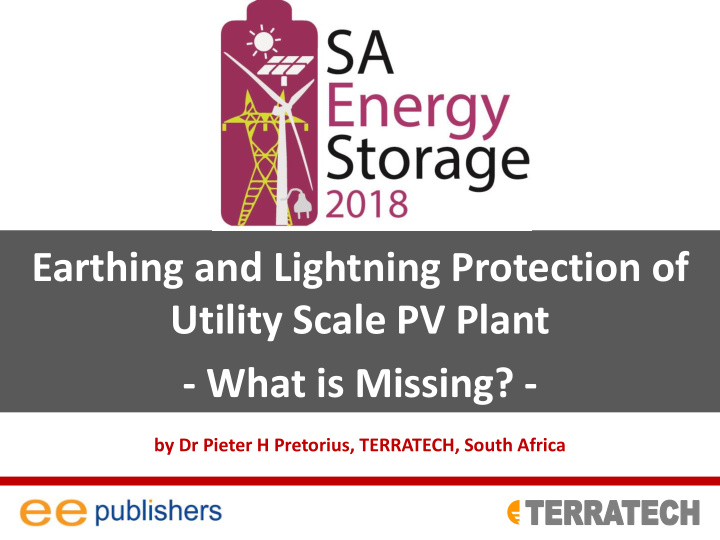



Earthing and Lightning Protection of Utility Scale PV Plant - What is Missing? - by Dr Pieter H Pretorius, TERRATECH, South Africa
OVERVIEW INTRODUCTION IMPLICATIONS - DESIGN IMPLICATIONS – INSTALLATION MITIGATION OPTIONS CONCLUDING REMARKS 2
INTRODUCTION Context – Large, Free Field Photovoltaic Plant; Experience has shown that earthing and lightning protection deserves special attention; With more responsibility / accountability now on the EPC contractor for lightning protection, in particular, and with a new round of projects developing in South Africa as well as Sub- Saharan Africa, it is imperative that awareness be created of what can go wrong in the context of earthing and lightning protection; 3
IMPLICATIONS - DESIGN AIR TERMINATIONS Components of an external lighting protection system: Air termination rod Air termination rod Down conductor Earth electrode 4
IMPLICATIONS - DESIGN AIR TERMINATIONS – No air terminations 5
IMPLICATIONS - DESIGN AIR TERMINATIONS - Reason Thermogram of polycrystalline cells shaded by lightning rod and the view of shaded part of PV module . Ref: E Bozek, G Basista, Thermographic Research of Photovoltaic System Operating in Shaded 6 Conditions Measurement Automation Monitoring, Jun. 2015, vol. 61, no. 06
IMPLICATIONS - DESIGN AIR TERMINATIONS - Analogy 7
IMPLICATIONS - DESIGN LIGHTNING GROUND POTENTIAL RISE (GPR) Potential (V) Distance from Strike Point (m) Potential function of soil resisity and electrode geometry / mesh density 8
IMPLICATIONS - DESIGN o Higher soil resistivity presents higher GPR, as expected; o Higher frequencies in the lightning current have a localized effect on the GPR; o The localized effect of the GPR eradicates the “equipotential” across the electrode; o Equipotential (Quasi- equipotential) is only relevant at lower frequencies; Main point: Loss of Equipotential Ref: P H Pretorius, Loss of Equipotential During Lightning Ground Potential Rise on Large Earthing Systems, Joint IEEE International Symposium on Electromagnetic Compatibility & Asia ‐ Pacific Symposium on Electromagnetic Compatibility (2018 Joint IEEE EMC & APEMC), Suntec Convention and Exhibition Centre, Singapore, 14 to 17 9 May 2018.
IMPLICATIONS - DESIGN 8,3 m 4,5 m Calculated GPD across part of an electrode shown Part of PV plant electrode with panel support structures. Finding: Over relatively short distances (23 m to 50 m), significant differences in potential (up to 66.1 kV) can be presented. Ref: P H Pretorius, Loss of Equipotential During Lightning Ground Potential Rise on Large Earthing Systems, Joint IEEE International Symposium on Electromagnetic Compatibility & Asia ‐ Pacific Symposium on Electromagnetic Compatibility (2018 Joint IEEE EMC & APEMC), Suntec Convention and Exhibition Centre, Singapore, 14 to 17 May 2018. 10
IMPLICATIONS - DESIGN LIGHTNING GROUND POTENTIAL RISE (GPR) Standards – limited application - lightning risk assessment – not so obvious: IEC 62305-2, supported by Parts 1, 3 and 4 forms, together, perhaps the most elaborate set of lightning protection standards referenced in many countries, including South Africa. However, it is specifically noted from IEC 62305-4: “ The scope of this part of IEC 62305 deals with the protection of equipment within structures and not protection of interconnected structures to which isolation transformers may provide some benefit ”. Finding: This is seen as a limitation of the standard (in the context of the discussion on lightning GPR) that requires further attention in future versions of the standard. 11 Ref: IEC 62305- 4, “Protection Against Lightning - Part 4: Electrical and Electronic Systems Within Structures”, 2010
IMPLICATIONS - DESIGN UNIQUE CONDITIONS (SOUTH AFRICA) * High soil resistivity (> 1000 Ω .m) * Lightning activity ( 3 – 6 Flashes / km 2 / year) * Wire-line technology Ref: P H Pretorius, On Ground Potential Rise Presented by Small and Large Earth Electrodes Under Lightning Conditions, IEEE AFRICON 2017, Victoria and Alfred (V&A) Waterfront Cape Town, South Africa, 18 to 20 September 2017. P H Pretorius, C R Evert, Elevated Lightning Flash Density at Large PV Plant Environments – A Hypothesis and Preliminary Findings, CIGRE, 8th Southern Africa Regional Conference, Lord Charles Hotel, Somerset West, Cape Town, 14 – 17 Nov 2017. 12
IMPLICATIONS - DESIGN UNIQUE CONDITIONS (SOUTH AFRICA) * High soil resistivity (> 1000 Ω .m) * Lightning activity ( 3 – 6 Flashes / km 2 / year) * Wire-line technology 13
IMPLICATIONS - INSTALLATION SMALL MISTAKES CAN CONTRIBUTE TO DAMAGE 14
IMPLICATIONS - INSTALLATION SMALL MISTAKES CAN CONTRIBUTE TO DAMAGE 15
IMPLICATIONS - INSTALLATION HOW MUCH PAIN One thunderstorm – 3 direct strikes (-30 kA; -11kA; -17 kA): R 1,5 m ($ 104,000) 16
MITIGATION OPTIONS Philosophy: “Give and take and use knowledge available” (Protect the Boxer and use your arms) 17
MITIGATION OPTIONS Lightning GPR not a new phenomenon – existing techniques to mitigate; No Air Terminations - Harden Equipment; - Improve Zoning (LPS, EM); - Better shielding; Air Terminations - Supplement (German only) 18
MITIGATION OPTIONS Lightning GPR - Consider in Risk Assessment - Single Point Earthing - Apply isolation devices; - Technology selected(eg Fibre vs Wire Line) Installation - Inform Site Supervisor - Quality Management Procedures 19
CONCLUDING REMARKS To answer the question: What is missing? * Awareness of damage mechanisms and how to design for these in specific conditions. * Awareness of unique conditions that contribute to damage; * Awareness of implication of small installation errors. * Awareness of mitigation options. Possible role to create awareness by Participating Universities / SAIEE Lightning Chapter. 20
THANK YOU Thank you for your kind attention. Questions are welcome. Pieter H Pretorius, PhD TERRATECH, South Africa www.terratechnology.co.za office@terratechnology.co.za 21
Recommend
More recommend